
Posted on 07/16/2011 5:58:26 AM PDT by Homer_J_Simpson

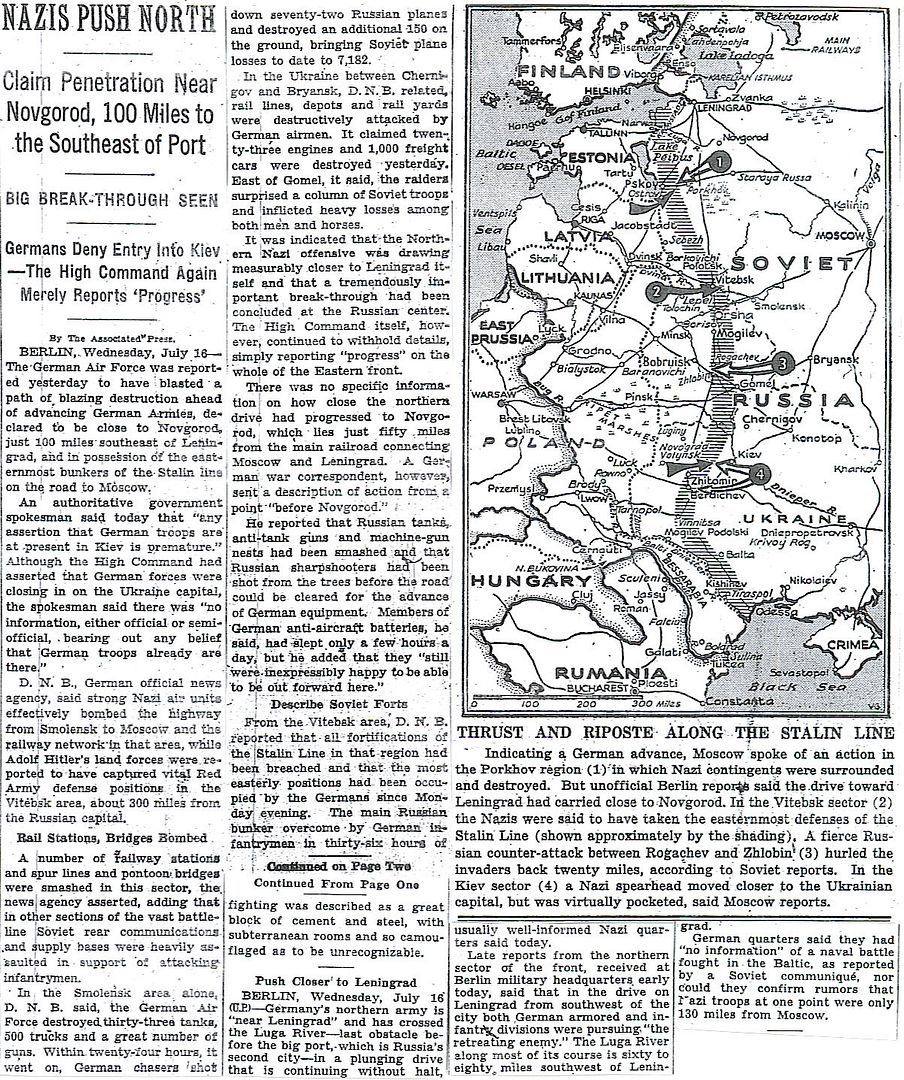
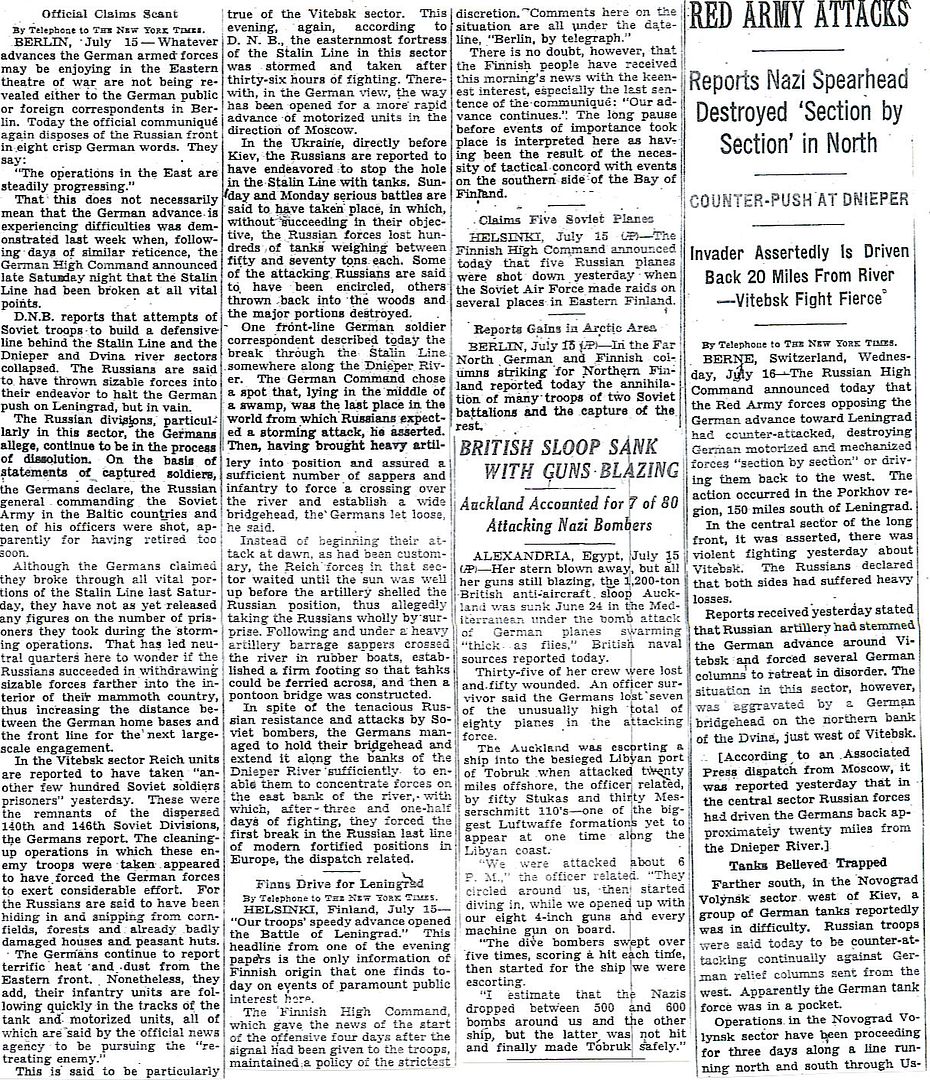

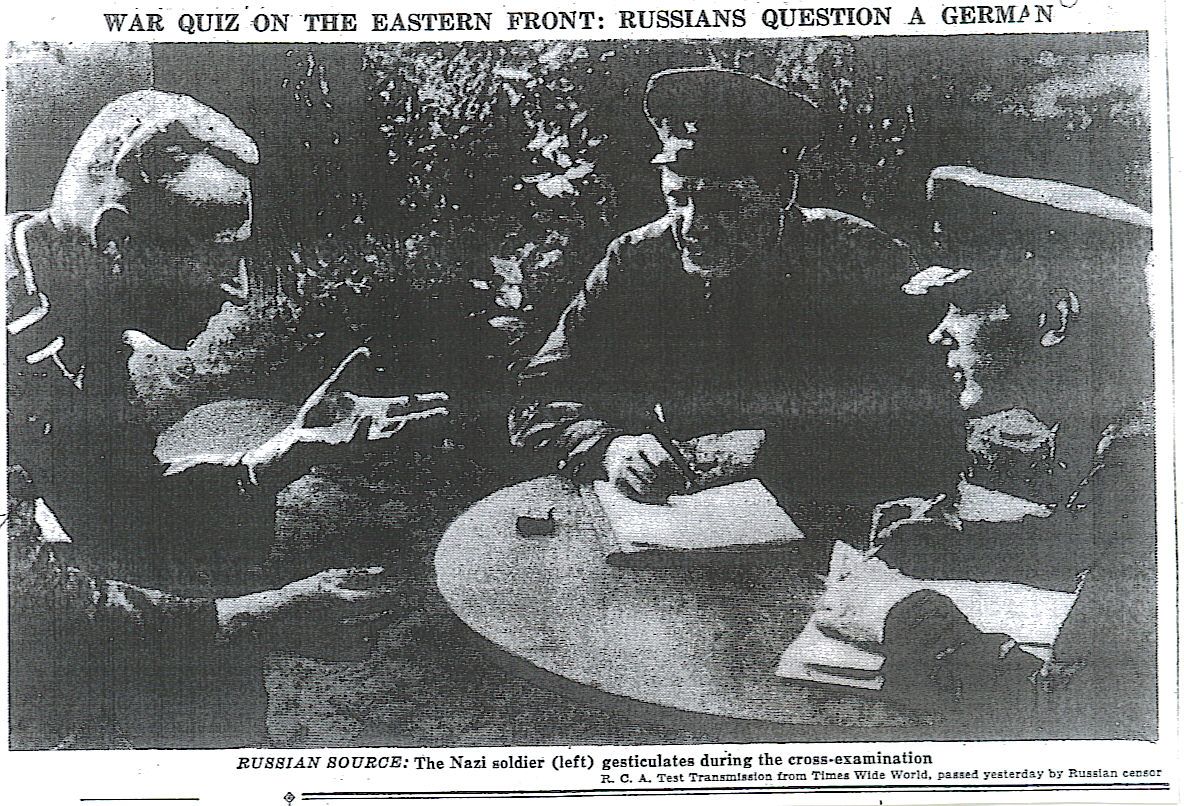

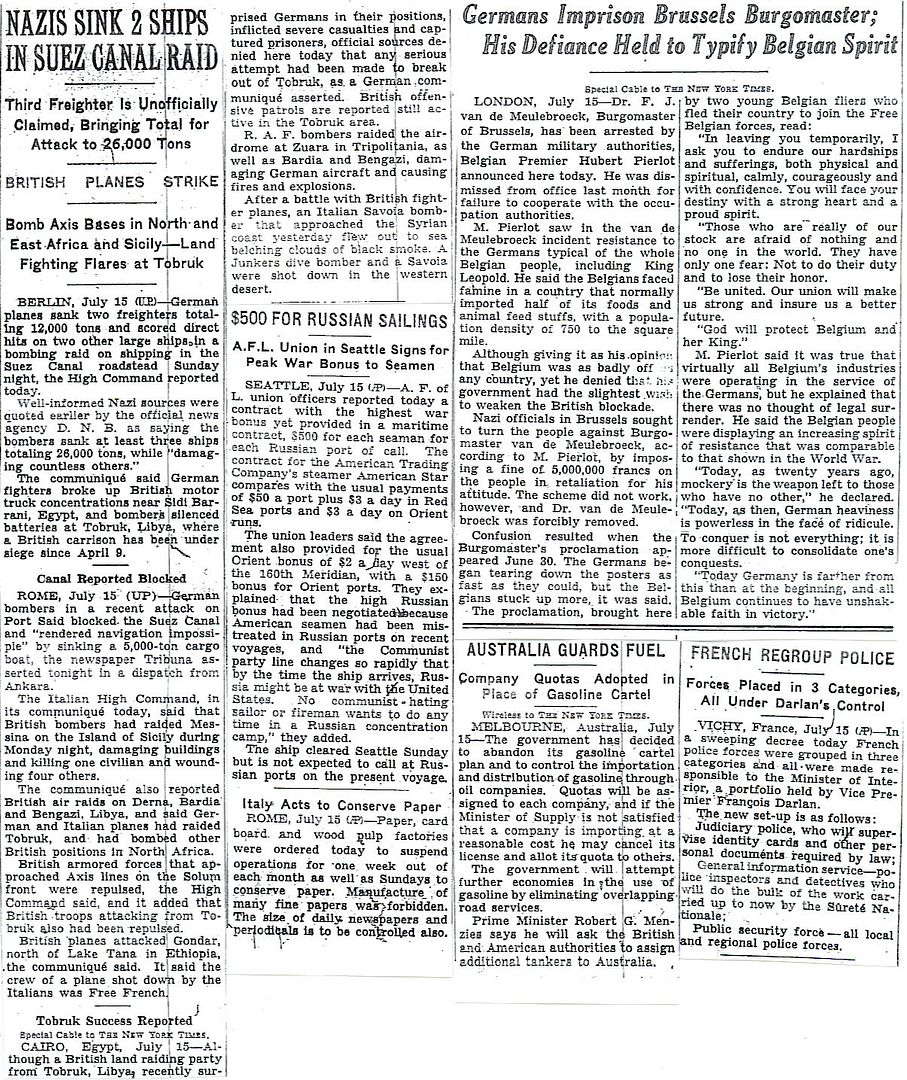
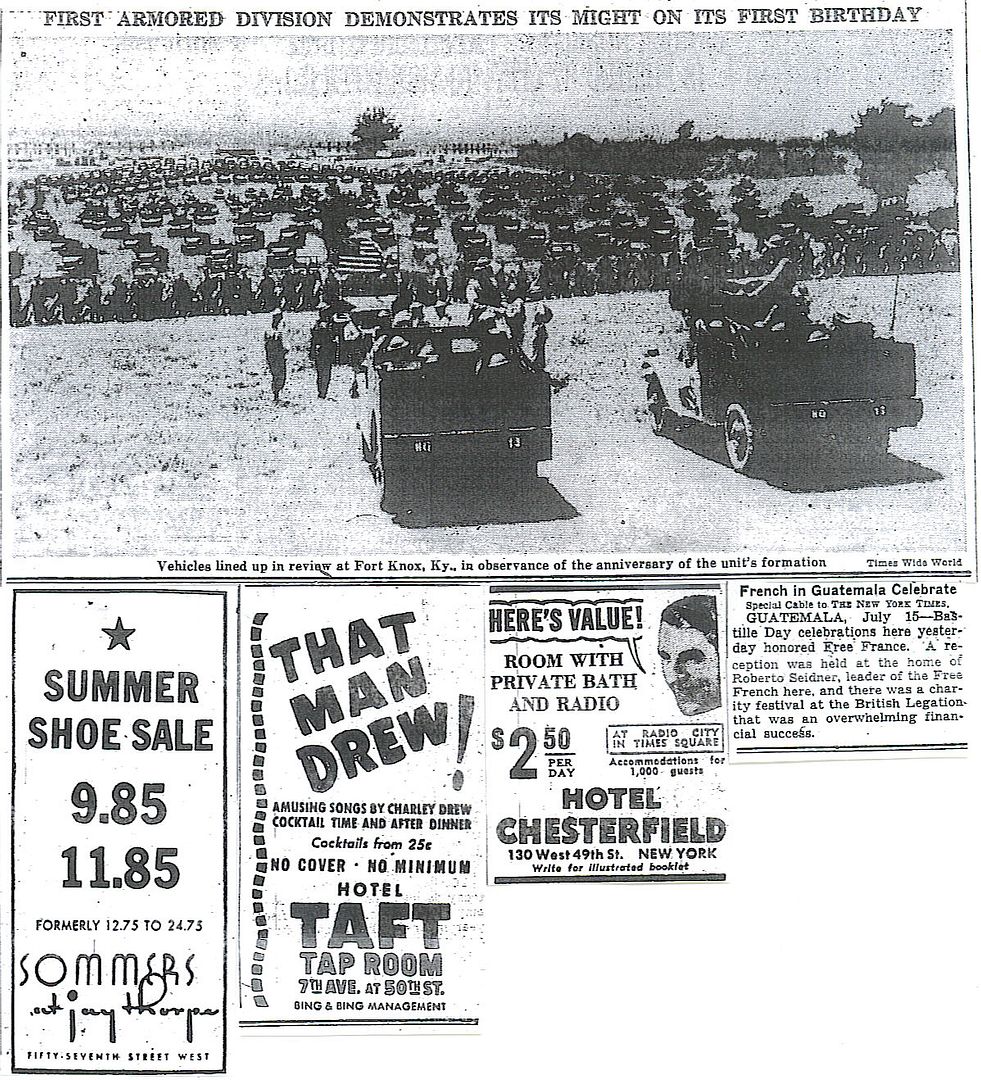
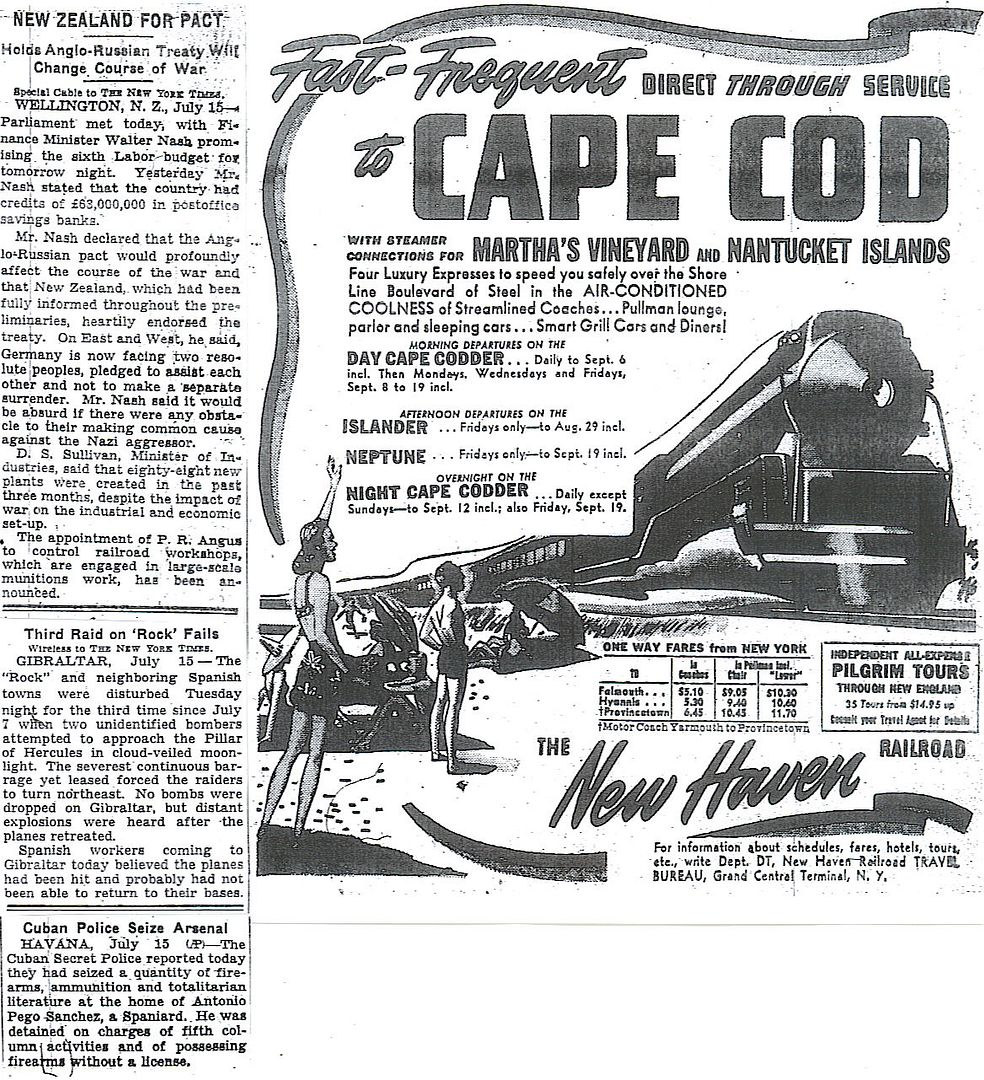


Revealed: how Stalin's brutal massacre at Katyn shamed his PoW son into suicide
http://www.onwar.com/chrono/1941/jul41/f16jul41.htm
Germans surround Soviets near Uman
Wednesday, July 16, 1941 www.onwar.com
On the Eastern Front... The Finnish attacks north of Lake Ladoga take Sortavala and reach the Lake to the southeast of the town, cutting off Soviet forces to the west. The Soviets will be able to get some of their troops away by boat. Attacks by German Army Group South surround a Soviet force south of Uman.
In Berlin... At an important meeting Hitler, Goring, Bormann and Rosenberg decide on plans for the exploitation of the territory begin captured from the Soviets. Rosenberg is put in charge of a new ministry with the task of organizing the new lands for Germany’s economic benefit and eliminating Jews and Communists.
In Vichy France... General Weygand is appointed Governor General of Algeria.
In Tokyo... In order to remove Masuoka from the Foreign Ministry, Prince Konoye resigns.
http://homepage.ntlworld.com/andrew.etherington/month/thismonth/16.htm
July 16th, 1941
UNITED KINGDOM: RAF Bomber Command: 2 Group: 36 Blenheims from 18, 21, 105 and 139 Sqns. Considerable damage is done to dock installations and 22 ships in berth. Four aircraft are lost to flak.
FRANCE: Corvette FS Lobelia commissioned. (Dave Shirlaw)
GERMANY: In Führer’s headquarter the German leaders plan how the Soviet territory is to be divided after the final victory. All the ‘booty’ is to be German, even if initially Germany is to stress the liberation of peoples from Soviet yoke. Ukraine and Crimean peninsula is to be German. Finland can have East Karelia, but the Kola peninsula is for Germany. Hitler also orders that the preparations for the annexation of Finland into Greater Germany should be started in utmost secrecy. (Mikko Härmeinen)
U-701 commissioned.
U-408 launched. (Dave Shirlaw)
U.S.S.R.: The Germans Stalin’s son, artillery regiment Lieutenant Jacob Dzhugashvili, prisoner.
Finnish troops take up positions at the northern end of Lake Ladoga.
EQUATORIAL AFRICA: Brazzaville: General de Gaulle repudiates the Saint Jean D’Acre convention which made no mention of the Free French.
JAPAN: Prince Konoye resigns as Japanese Prime Minister. Foreign Minister Matsuoka has advocated joining Germany in the attack against the USSR. He will not be in the cabinet when it is reformed on the 18th.
U.S.A.: While anchored off the Staten Island, New York quarantine station, the transport USS West Point (AP-23) (ex SS America) takes 137 Italian and 327 German citizens, from the consulates of those nations in the United States which had been closed, on board and gets underway at 1455 hours local, bound for Lisbon, Portugal. USS West Point was granted safe-conduct for the voyage by the British. (Jack McKillop)
Baseball, the New York Yankees travel from Chicago to Cleveland, Ohio, to play the Cleveland Indians in League Park. Yankee center fielder Joe DiMaggio extends his hitting streak to 56 consecutive games by going 3-for-4 against Cleveland pitchers Al Milnar and Joe Krakauskas. (Jack McKillop)
Gerow recommends to Marshall that the Philippine Army be called up, that MacArthur be given overall command, and that $10 million be spent on this from the Executive Fund and that the $52 million from the Sugar Excise Fund be released for Philippine defence, as well.
British POWs at Sachsenhausen. I knew that Russian prisoners wound up in concentration camps but not the British. I wonder if they were Jews or has also attempted to escape.
Wehrmacht vs. Red Army, who do you root for?
You really want both to lose, but in the context of 1941, Nazi Germany was the more immediate threat.
Unfortunately the last chance for a “good” outcome died with the Hitler-Stalin pact. Once that was signed, Eastern Europe’s fate was sealed. The only question was which brutal tyranny would rule over the East.
If I recall correctly, there were American POWs at Mauthausen [airmen, I believe]. The SS worked a number of them to death carrying rock from the quarry up to the camp.
Wehrmacht
On 22nd June the German divisions had successfully crossed the frontier rivers also in the south, and had pushed through the enemy's fortified positions along the border.
But the planned rapid break-through on the northern wing did not materialize. To make a single Panzer Group the striking force for the conquest of so large and so well defended an area as the Ukraine had been a planning mistake.
The rapid successes on the Central Front had been achieved by revolutionary tactical skill. There the two powerful Panzer Groups, boldly led, had encircled and liquidated the bulk of the Soviet defending forces. In the south and in the north, on the other hand, the absence of a two-pronged attack made it impossible to reach the intended targets.
There simply were not enough armored formations for the kind of vast-scale operation Hitler expected his armies in the east to perform along the entire front. Failure to reach the scheduled targets in the south was not due to any lack of skill on the part of the commanders, nor to any lack of courage, nor, least of all, to a lack of staying power on the part of the troops. It was simply due to the fact that there were too few armored units—to a numerical shortage of the very service branch intended to carry the whole of Operation Barbarossa.
In the early light of 7th July Kleist's Panzer Group succeeded in penetrating the Stalin Line on both sides of Zvyagel. The llth Panzer Division under Major-General Crüwell pierced the line of pillboxes and fortifications in full depth and by a bold stroke took the town of Berdichev at 1900 hours. The Russians withdrew. But they did not retreat everywhere.
The 16th Motorized Infantry Division got stuck in the line of pillboxes near Lyuban. There the Russians even counter-attacked with armor.
General Hübe's 16th Panzer Division likewise encountered stiff resistance at Starokonstantinov. The troops ran out of ammunition. Transport aircraft had to bring up supplies for the tanks. Bombers, Stukas, and fighter bombers of Fourth Air Fleet came to the division's assistance and smashed concentrations of Soviet armor.
The combat group Hofer of 16th Panzer Division drove farther to the east and overran retreating artillery regiments. The 1st Battalion, 64th Rifle Regiment, experienced its most costly day of close combat at Stara Bayzymy. Within two hours the 1st Company lost three successive company commanders.
At long last, with the help of 21-cm. mortars, the bulk of 16th Panzer Division broke through the Stalin Line at Lyuban on 9th July. General Hube heaved a sigh of relief: only another 125 miles to the Dnieper.
The only pleasant feature of these weeks was the abundance of eggs. Early in July the division had captured an enormous Red Army food store with a million eggs. The quartermasters replenished their stocks. For a long time the only worry of the NCO cooks was inventing new ways of serving eggs.
The fighting had been going on for over twenty days, and no decisive success had so far been achieved. There was some impatience at the Fuehrer's headquarters. Things were moving too slowly for Hitler. Suddenly he got the idea that "small pockets" would be a better plan. He therefore demanded that Kleist's Panzer Group should operate as three separate combat groups with the object of forming smaller pockets. One combat group was to form a tiny pocket near Vinnitsa, in conjunction with Eleventh Army coming up from the south.
Another group was to drive towards the south-east in order to cut off any enemy forces intending to withdraw from the Vinnitsa area. A third combat group, finally, was to drive towards Kiev, together with Sixth Army, and to gain a bridgehead on the eastern bank of the Dnieper.
Field-Marshal von Rundstedt emphatically objected to having his one and only Panzer Group split up in such a manner. This, he argued, was an unforgivable sin against the spirit of armoured warfare. "Operations in driblets won't give results anywhere," he telephoned to Hitler's headquarters. Hitler relented.
On the western bank of the Dnieper Kleist's Panzer Group pushed past Kiev towards the south-east with concentrated forces, and thus created the prerequisite either for describing a smaller arc towards Vinnitsa or a larger one towards Uman.
Everything was set for a small and for a large pocket south of Kiev. All the factors had been carefully taken into account, except one—Budennyy.
The Marshal with the bushy moustache, who had been appointed Commander-in-Chief Army Group South-west Sector on 10th July, now played his final card. From the impenetrable Pripet Marshes, impassable to armor, he sent the divisions of his Fifth Rifle Army under Major-General Potapov against the northern flank of Reichenau's Sixth Army. These tactics, just as in the area of Army Group Centre, gave rise to severe and critical defensive fighting on Reichenau's left flank. But here, too, all went well in the end.
On 16th July Kleist's tanks reached the key centre of Belaya Tserkov. The first major battle of encirclement offered itself.
It was not a huge pocket as at Bialystok, Minsk, or Smolensk. Nevertheless three Soviet Armies were smashed—the Sixth, the Twelfth, and the Eighteenth. The commanders-in-chief of the Sixth and Twelfth Armies surrendered. But 'only' 103,000 prisoners were taken as a result of this classical battle of encirclement with reversed front, fought under such exceedingly difficult conditions.
Considerable enemy forces succeeded in breaking out, even though the 1st and 4th Mountain Divisions, as well as the 257th Infantry Division from Berlin, repeatedly tried hard to seal the gaps.
Major Wiesner's 1st Artillery Battalion, 257th Infantry Division, fired as accurately as if on the practice range and blasted column after column trying to break out of the pocket. The scale of the fighting is reflected in a single figure: the four guns of 9th Battery, 94th Mountain Artillery Regiment, fired 1150 rounds during the four days of the battle of Uman. That was more than the total rounds fired by the battery throughout the campaign in France.
The enemy weapons destroyed or captured testified to the fierceness of the fighting: 850 guns, 317 tanks, 242 anti-tank and anti-aircraft guns were abandoned by the Russians on the battlefield. Yet the significance of the battle of Uman considerably surpasses these numerical results. The strategic implications of the victory won by Army Group South were considerably greater than the number of prisoners suggested.
The road to the east, into the Soviet iron-ore region of Krivoy Rog and to the Black Sea ports of Odessa and Nikolayev, was open. Above all, Kleist's Panzer Corps was now able to push through to the lower Dnieper and to gain the western bank of the Dnieper bend from Cherkassy to Zaporozhye. This move, moreover, offered the chance of a great battle of annihilation around Kiev—a chance which so mesmerized Hitler that he halted Army Group Centre's offensive against Moscow and diverted Guderian's tanks to the south, towards Kiev. These two great armored prongs were now to embark on a new gigantic battle of encirclement against the Soviet South-west Front with its one million men.

German unit Northeast of Smolensk searches for roads (around the city?). July 1941
In the Ukraine-late July-early Aug 1941
Somewhere south of Smolensk -Summer 1941
German assault troops in the suburbs of Smolensk July 1941
German supply vehicles somewhere between Orsha & Smolensk -undated
German medical team watch as Ukrainian village is cleared. Aug 1941
KV-2 with a damaged transmission sits on the road west of Krassny Bor (near Smolensk_ undated
Somewhere in Army Group Center -dated 1941 -no description
German soldier seconds after he was wounded by sniper. No location, but probably Estonia in Aug 1941
Photo probably taken late in 1941
Part of Soviet convoy overrun east of Rovno July 1941
The underequipment [and performance] of AG South can be laid squarely at the door of Brauchitsch, and especially Halder, and their monomaniacal focus on Moscow.
Despite Hitler’s order that the focus of BARBAROSSA was, after the annihilation of the Red Army in Eastern Poland/ Western Russia and Ukraine, taking Ukraine and the area from the Baltic States to Leningrad, Halder and Brauchitsch placed the bulk of the armor on the Minsk-Smolensk-Moscow axis. While the effect of this was somewhat lessened in the north, Rundstedt’s AG faced crossing serial riversd perpendicular to his front, with a largely impassable swamp on his left flank, and the Black Sea on his right.
Even when Bock’s right flank hung open for several hundred miles, Halder and Brauchitsch continued to push for the push on Moscow. While Bock and Guderian agreed with them, Kluge, Busse and Rundstedt did not. It was only when Hitler, acting as referee, ordered the Kiev encirclement [which not only freed up Rundstedt, but appreciable shortened the German lines]that [temporarily] Halder and Brauchitsch were silenced. But they came back to their pet project when Budenny’s troops surrendered. And the damage had already been done.
If the photo of the SS helmeted graves is from near Smolensk, I would assume the unit was either 2d SS, “DAS REICH”, or 5th SS “WIKING”.
That’s an interesting photo of Stalin’s son’s capture. The German on the left is Luftwaffe. The German on the right is SS.
I still can't find an exact date (for the photo) but the area is Yelnya. Other photos with that one are mostly from July & August, if that helps.
Disclaimer: Opinions posted on Free Republic are those of the individual posters and do not necessarily represent the opinion of Free Republic or its management. All materials posted herein are protected by copyright law and the exemption for fair use of copyrighted works.